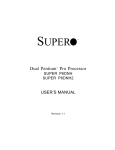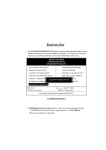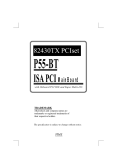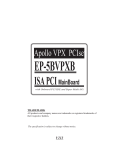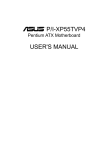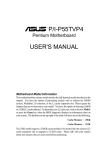Download Pentium System
Transcript
SUPER ® ® Pentium System P5MMA98/P5MMS98 P5MMA2/P5MMS2 USER’S MANUAL Revision 1.3 The information in this User’s Manual has been carefully reviewed and is believed to be accurate. The vendor assumes no responsibility for any inaccuracies that may be contained in this document, makes no commitment to update or to keep current the information in this manual, or to notify any person or organization of the updates. SUPERMICRO COMPUTER reserves the right to make changes to the product described in this manual at any time and without notice. This product, including software, if any, and documentation may not, in whole or in part, be copied, photocopied, reproduced, translated or reduced to any medium or machine without prior written consent. IN NO EVENT WILL SUPERMICRO COMPUTER BE LIABLE FOR DIRECT, INDIRECT, SPECIAL, INCIDENTAL, OR CONSEQUENTIAL DAMAGES ARISING FROM THE USE OR INABILITY TO USE THIS PRODUCT OR DOCUMENTATION, EVEN IF ADVISED OF THE POSSIBILITY OF SUCH DAMAGES. IN PARTICULAR, THE VENDOR SHALL NOT HAVE LIABILITY FOR ANY HARDWARE, SOFTWARE, OR DATA STORED OR USED WITH THE PRODUCT, INCLUDING THE COSTS OF THE REPAIRING, REPLACING, OR RECOVERING SUCH HARDWARE, SOFTWARE, OR DATA. Unless you request and receive written permission from SUPERMICRO COMPUTER, you may not copy any part of this document. Information in this document is subject to change without notice. Other products and companies referred to herein are trademarks or registered trademarks of their respective companies or mark holders. Copyright © 1997 by SUPERMICRO COMPUTER INC. All rights reserved. Printed in the United States of America. Preface About This Manual This manual is written for system houses, PC technicians and knowledgeable PC end users. It provides information for the installation and use of the SUPER P5MMA98/P5MMS98/P5MMA2/P5MMS2 motherboard, which supports the 75/90/100/120/133/150/166/180/ 200/233 MHz Intel ® Pentium ® processor, Cyrix/IBM 5x86, 6x86, AMD-K5, AMD-K6, MMX TM and future Pentium processors. The Intel Pentium processor will take personal computer systems to a new level of performance. The emergence of the PCI local bus will also have a significant impact on PCs. Memory and I/O components have also made significant strides in both performance and integration, enhancing the CPU’s ability to move data quickly. Putting these all together creates the next generation of PC systems. Manual Organization Chapter 1, Introduction, describes the features, specifications and performance of the SUPER P5MMA98/P5MMS98/P5MMA2/P5MMS2 system board, provides detailed information about the chipset, cache memory, main memory system, PC health monitoring, ACPI, PC 98 and offers warranty information. Refer to Chapter 2, Installation, for instructions on handling staticsensitive devices, checking and/or configuring the jumpers for manufacturing. Read this chapter when you want to configure CPU and voltage settings, install or remove SIMM/DIMM memory modules, and to mount the system board in the chassis. Also refer to this chapter to connect the floppy and hard disk drives, enhanced IDE configurations, Infrared, USB, parallel port, serial ports, as well as the cables for the power supply, reset cable, Keylock/Power LED, speaker, overheat fan and keyboard. iii P5MMA98/P5MMA2/P5MMS98/P5MMS2 User's Manual If you encounter any problem, please see Chapter 3, Troubleshooting, which describes troubleshooting procedures for video, memory, and the setup configuration stored in memory. Instructions are also included on contacting a technical assistance support representative and returning merchandise for service and the BBS# for BIOS upgrading. i v Preface Table of Contents Preface.......................................................................... iii About This Manual ......................................................................................... iii Manual Organization ...................................................................................... iii Quick Reference ........................................................................................... viii Chapter 1: Introduction ............................................. 1-1 1-1 Overview ............................................................................................... 1-1 SUPER P5MMA98 Motherboard Layout ................................... 1-4 SUPER P5MMA2 Motherboard Layout ..................................... 1-5 SUPER P5MMS98 Motherboard Layout ................................... 1-6 SUPER P5MMS2 Motherboard Layout ..................................... 1-7 SUPER P5MMA98 Features ....................................................... 1-8 SUPER P5MMA2 Features ....................................................... 1-10 SUPER P5MMS98 Features ..................................................... 1-12 SUPER P5MMS2 Features ....................................................... 1-14 1-2 PC Health Monitoring ....................................................................... 1-16 1-3 ACPI/PC 98 Features ....................................................................... 1-19 1-4 Power Supply .................................................................................... 1-21 1-5 Chipset Overview .............................................................................. 1-21 1-6 Super I/O Controller .......................................................................... 1-22 1-7 Warranty, Technical Support, and Service .................................. 1-23 Parts .............................................................................................. 1-23 BIOS .............................................................................................. 1-23 Labor ............................................................................................. 1-23 Returns ......................................................................................... 1-23 v Chapter 2: Installation ............................................... 2-1 2-1 Static-Sensitive Devices ................................................................... 2-1 Precautions ................................................................................... 2-1 Unpacking ...................................................................................... 2-1 2-2 Configuring System Board Jumpers .............................................. 2-2 Manufacturing Settings ............................................................... 2-2 Changing the CPU Speed ......................................................... 2-3 CPU Voltage Settings ................................................................. 2-5 On-Board Memory ........................................................................ 2-6 Cache Size Selection .................................................................. 2-6 Green PC Function ...................................................................... 2-6 2-3 Mounting the Motherboard in the Chassis ................................... 2-6 2-4 Connecting Cables ............................................................................ 2-7 Power Supply Connectors .......................................................... 2-7 PS/2 Keyboard and Mouse Ports ............................................. 2-8 AT Keyboard Connector ............................................................... 2-9 Reset Cable Connector ............................................................ 2-10 Keylock/Power LED Cable Connector ................................... 2-10 Hard Drive LED .......................................................................... 2-11 Speaker Cable Connector ........................................................ 2-11 PW_ON Connector ..................................................................... 2-12 Infrared Connector ..................................................................... 2-12 FIR and CIR Connector ............................................................ 2-13 CMOS Clear ................................................................................. 2-14 BIOS Flash Protection ............................................................... 2-14 PC Health Monitor IRQ .............................................................. 2-14 Overheat LED .............................................................................. 2-15 External Battery ........................................................................... 2-15 Overheat Fan (2-pin) ................................................................. 2-16 Overheat Fan (3-pin) ................................................................. 2-16 CPU Fan ....................................................................................... 2-17 v i Table of Contents Chassis Fan ............................................................................... 2-17 Chassis Intrusion Connector .................................................. 2-18 Serial Ports .................................................................................. 2-18 USB Connectors ......................................................................... 2-19 Power On/Off State .................................................................... 2-19 2-5 Installing/Removing the SIMM/DIMM Modules ........................... 2-20 SIMM/DIMM Module Installation ............................................... 2-21 Removing SIMM/DIMM Modules .............................................. 2-21 2-6 Connecting Floppy and Hard Disk Drives .................................. 2-22 Parallel Port Connector ............................................................ 2-23 Floppy Connector ....................................................................... 2-24 Enhanced IDE Configurations ................................................ 2-25 Chapter 3: Troubleshooting ...................................... 3-1 3-1 Troubleshooting Procedures ........................................................... 3-1 No Video ........................................................................................ 3-1 Troubleshooting Flowchart ........................................................ 3-2 Memory Error ................................................................................. 3-3 Losing the System’s Setup Configuration .............................. 3-3 3-2 Technical Support Procedures ........................................................ 3-4 3-3 Returning Merchandise for Service ................................................ 3-4 vii P5MMA98/P5MMA2/P5MMS98/P5MMS2 User's Manual Quick Reference Jumpers Function JP2 CMOS Clear JP3 External Battery JP5, JP6, JP7 Bus Speed JP9 (MMA98) Overheat Fan (2 pins) JP15 (MMS98) Overheat Fan (2 pins) JP24 (MMA98) Power On/Off State JP27 (MMS98) Power On/Off State J7 Boot Block Protection J35, J36 Clock Multiplier J45 (MMS98) Overheat LED J46, J47, J48, J49 (MMA98) CPU Voltage J55 (MMS98) IRQ for PC Health J43 (MMA98) IRQ for PC Health J42 (MMA98) Overheat LED J51, J44 (MMA98) CPU Fan J54 (MMS98) CPU Fan J41 (MMA98) Overheat Fan (3 pins) J53 (MMS98) Overheat Fan (3 pins) J58 (MMS98) Chassis Fan J59 (MMS98) Chassis Intrusion J50 (MMA98) Chassis Intrusion J37 (MMS98) USB J38 (MMA98) USB viii Page 2-14 2-15 2-3 2-16 2-16 2-19 2-19 2-14 2-3 2-15 2-5 2-14 2-14 2-15 2-16 2-16 2-16 2-16 2-17 2-18 2-18 2-19 2-19 Chapter 1: Introduction Chapter 1 Introduction 1-1 Overview SUPER P5MMA98, P5MMS98, P5MMA2, P5MMS2 are PC 98-ready motherboards designed to maximize user satisfaction and simplicity in managing the personal computer. The four motherboards support Intel ® Pentium ® 233/200/180/166/150/133/120/100/90/75 MHz, Cyrix/IBM 5x86, 6x86, AMD-K5, AMD-K6 and MMXTM processors. They are based on Intel's advanced 430TX chipset to provide the best possible platform for multimedia applications. They support Synchronous DRAM (SDRAM), Concurrent PCI, and 33 MB/s Ultra DMA for fast disk reads and writes. All motheboards support PC Health Monitoring features including CPU fan auto-off in sleep mode, CPU overheat alarm and LED, hardware BIOS virus protection, and a switching voltage regulator for the CPU core. SUPER P5MMA98 and P5MMS98 have an LM78 chip on-board which support additional PC Health Monitoring features, including seven voltage monitors, fan status monitors with firmware/software control on/off, CPU/chassis temperature monitors, Intel LANDesk® Client Manager support, and system resource alert. A chassis intrusion detection prevents system tampering. ACPI/PC 98 features include Microsoft ® OnNow power management, with a slow blinking LED to indicate the system is in the sleep state, BIOS support for the USB (Universal Serial Bus) keyboard, and real time clock wake-up alarm. The motherboards provide a main switch override mechanism, and external modem ringon if the system is in a SoftOff state. SUPER P5MMA98 and P5MMA2 are ATX size (12" x 8.3"). SUPER P5MMS98 and P5MMS2 are baby AT size (11" x 8.3"). All support up to 256 MB of FPM, EDO, or SDRAM, with 512 KB pipelined burst SRAM or L2 cache, using two 168-pin unbuffered 3.3 V DIMM sock- 1-1 SUPER P5MMA98/P5MMS98/P5MMA2/P5MMS2 User’s Manual ets and four 72-pin 5 V SIMM sockets. They include four PCI and four ISA slots with two EIDE, one floppy, ECP/EPP parallel port, PS/ 2 mouse and keyboard connectors, two 16550-based serial ports, two USBs, and a fast IR port. SUPER P5MMS98 and P5MMS2 support 2 Mb/s back-up tapes. Figure 1-1. SUPER P5MMA98 Motherboard Picture 1-2 Chapter 1: Introduction Figure 1-2. SUPER P5MMS98 Motherboard Picture For maximum flexibility, all four motherboards support AT or ATXtype power supply. The AMI WinBIOS has a 1 Mb flash memory for convenient BIOS upgrade. The BIOS supports Advanced Power Management (APM), Plug and Play, and PC health management. 1-3 SUPER P5MMA98/P5MMS98/P5MMA2/P5MMS2 User’s Manual J4 PS/2 KB PS/2 MOUSE PW1 J16 AT POWER ATX POWER J41 J44 U17 U14 JP9 1 PMC FAN J37 USB J38 J41, JP9: THERMAL FAN J51 U16 CPU J46 J47 J48 J49 J5 COM2 J3 PRINTER 1 1 1 1 JP7 JP6 JP5 1 J35 J36 J40 U13 J34 Bank1 JJ5 COM1 J33 Bank1 J20 J32 NOTE: DO NOT POPULATE U6, J33, AND J34 AT THE SAME TIME! J21 1 1 Bank2 J19 J31 1 U5 Bank0 IDE 2 U6 Bank1 IDE 1 FLOPPY Bank2 1 J14 JP24 1 J13 BT2 U29 J12 J11 JJ10 JP3 JP2 J43 J7 1 1 1 1 J10 ® P5MMA98 BATTERY + U15 BIOS UPER U1 J9 J50 S J8 ——–——— Manufacturer Settings ———— JP2: 1-2 J40: OFF JP24: 2-3 J43: OPEN J7: 1-2 ——–———————–————––——–—–— ——–—————————–———————— Cyrix/IBM Jumper Settings: p. 2-4 AMD Jumper Settings: p. 2-4 Future CPU Settings: p. 2-5 CPU Voltage Settings: p. 2-5 CMOS Clear: p. 2-14 ——–———————–————––——–—–— U39 LM78 J42 HDD LED/KB LOCK/SPEAKER JJP23 1 1 JP23 IR PWR SW RESET ————–———–—Intel CPU Speed————––—–———— J36 J35 JP5 JP6 JP7 233 OFF OFF 1-2 2-3 2-3 (MMX) 200 OFF ON 1-2 2-3 2-3 180 OFF ON 2-3 2-3 1-2 166 ON ON 1-2 2-3 2-3 150 ON ON 2-3 2-3 1-2 (60 MHz Bus) 150 ON OFF 2-3 1-2 1-2 (75 MHz Bus) 133 ON OFF 1-2 2-3 2-3 120 ON OFF 2-3 2-3 1-2 100 OFF OFF 1-2 2-3 2-3 90 OFF OFF 2-3 2-3 1-2 75 OFF OFF 2-3 2-3 2-3 ——–—–——————————–————————————— Figure 1-3. SUPER P5MMA98 Motherboard Layout 1-4 Chapter 1: J4 PS/2 KB PS/2 MOUSE PW1 J16 AT POWER ATX POWER J41 J44 U17 U14 Introduction JP9 1 PMC FAN J37 USB J38 J41, JP9: THERMAL FAN U16 CPU J46 J47 J48 J49 J5 COM2 J3 PRINTER 1 1 1 1 JP7 JP6 JP5 1 J35 J36 J40 U13 J34 Bank1 JJ5 COM1 J33 Bank1 J20 J32 NOTE: DO NOT POPULATE U6, J33, AND J34 AT THE SAME TIME! J21 1 1 Bank2 J19 J31 1 U5 Bank0 IDE 2 U6 Bank1 IDE 1 FLOPPY Bank2 J14 JP24 1 J13 BATTERY + U29 J12 J11 JJ10 JP3 JP2 J43 J7 1 1 1 1 J10 ® P5MMA2 BT2 U15 UPER U1 BIOS J9 S J8 ——–——— Manufacturer Settings ———— JP2: 1-2 J40: OFF JP24: 2-3 J43: OPEN J7: 1-2 ——–———————–————––——–—–— ——–—————————–———————— Cyrix/IBM Jumper Settings: p. 2-4 AMD Jumper Settings: p. 2-4 Future CPU Settings: p. 2-5 CPU Voltage Settings: p. 2-5 CMOS Clear: p. 2-14 ——–———————–————––——–—–— J42 HDD LED/KB LOCK/SPEAKER JJP23 1 1 JP23 IR PWR SW RESET ————–———–—Intel CPU Speed————––—–———— J36 J35 JP5 JP6 JP7 233 OFF OFF 1-2 2-3 2-3 (MMX) 200 OFF ON 1-2 2-3 2-3 180 OFF ON 2-3 2-3 1-2 166 ON ON 1-2 2-3 2-3 150 ON ON 2-3 2-3 1-2 (60 MHz Bus) 150 ON OFF 2-3 1-2 1-2 (75 MHz Bus) 133 ON OFF 1-2 2-3 2-3 120 ON OFF 2-3 2-3 1-2 100 OFF OFF 1-2 2-3 2-3 90 OFF OFF 2-3 2-3 1-2 75 OFF OFF 2-3 2-3 2-3 ——–—–——————————–————————————— Figure 1-4. SUPER P5MMA2 Motherboard Layout 1-5 SUPER P5MMA98/P5MMS98/P5MMA2/P5MMS2 User’s Manual SUPER ® JP12 PS/2 MOUSE P5MMS98 JP10 J10 JP2 1 COM2 BATTERY + PS/2 MOUSE JP27 1 COM1 J11 J13 JP14 1 BT2 J42 - J9 J38 J37 J8 J12 JP13 PS/2 KB 1 JP11 AT KB PW1 JP9 1 J3 J14 1 PARALLEL J19 USB JP3 1 1 EXT BATTERY FLOPPY J21 J20 IDE #1 IDE #2 U15 J34 JP17 FIR CON 1 CONSUMER 1 IR U29 J33 J32 JP18 U5 U6 J31 NOTE: DO NOT POPULATE U6, J33, AND J34 AT THE SAME TIME! J56 U18 U37 LM78 U13 JP5 JP6 JP7 SMM SLOT J58 1 Bank Bank 0 1 U14 1 U17 U1 J16 J55 BIOS CPU J53 296-pin ZIF JP15 J47 J36 J35 J51 J50 J49 J48 Bank 1 1 ——–——— Manufacturer Settings ———— JP2: 1-2 J47: OFF JP27: 2-3 J55: OPEN J7: 1-2 ——–———————–————––——–—–— ——–—————————–———————— Cyrix/IBM Jumper Settings: p. 2-4 AMD Jumper Settings: p. 2-4 Future CPU Settings: p. 2-5 CPU Voltage Settings: p. 2-5 CMOS Clear: p. 2-14 ——–———————–————––——–—–— Bank 1 Bank 2 Bank 2 J59 1 J54 J45 J7 ATX POWER 1 U16 1 HD LED SPEAKER J57 J23 KEYLOCK PS ON RESET ————–———–—Intel CPU Speed————––—–———— J36 J35 JP5 JP6 JP7 233 OFF OFF 1-2 2-3 2-3 (MMX) 200 OFF ON 1-2 2-3 2-3 180 OFF ON 2-3 2-3 1-2 166 ON ON 1-2 2-3 2-3 150 ON ON 2-3 2-3 1-2 (60 MHz Bus) 150 ON OFF 2-3 1-2 1-2 (75 MHz Bus) 133 ON OFF 1-2 2-3 2-3 120 ON OFF 2-3 2-3 1-2 100 OFF OFF 1-2 2-3 2-3 90 OFF OFF 2-3 2-3 1-2 75 OFF OFF 2-3 2-3 2-3 ——–—–——————————–————————————— Figure 1-5. SUPER P5MMS98 Motherboard Layout 1-6 Chapter 1: SUPER ® JP12 PS/2 MOUSE P5MMS2 JP10 J10 JP2 1 COM2 BATTERY + PS/2 JP27 MOUSE 1 COM1 J11 J13 JP14 1 BT2 J42 - J9 J38 J37 J8 J12 Introduction JP13 PS/2 KB 1 JP11 AT KB PW1 JP9 1 J3 J14 1 PARALLEL J19 USB JP3 1 1 EXT BATTERY FLOPPY J21 J20 IDE #1 IDE #2 U15 J34 JP17 FIR CON 1 CONSUMER 1 IR U29 J33 J32 JP18 U5 U6 J31 NOTE: DO NOT POPULATE U6, J33, AND J34 AT THE SAME TIME! J56 J58 U13 JP5 JP6 JP7 SMM SLOT U18 1 Bank Bank 0 1 U14 1 U17 U1 J16 J55 BIOS CPU 1 ——–——— Manufacturer Settings ———— JP2: 1-2 J47: OFF JP27: 2-3 J55: OPEN J7: 1-2 ——–———————–————––——–—–— ——–—————————–———————— Cyrix/IBM Jumper Settings: p. 2-4 AMD Jumper Settings: p. 2-4 Future CPU Settings: p. 2-5 CPU Voltage Settings: p. 2-5 CMOS Clear: p. 2-14 ——–———————–————––——–—–— Bank 1 Bank 2 Bank 2 J53 296-pin ZIF JP15 J47 J36 J35 J51 J50 J49 J48 Bank 1 J54 J45 J7 1 HD LED SPEAKER J57 J23 KEYLOCK PS ON RESET ATX POWER 1 U16 ————–———–—Intel CPU Speed————––—–———— J36 J35 JP5 JP6 JP7 233 OFF OFF 1-2 2-3 2-3 (MMX) 200 OFF ON 1-2 2-3 2-3 180 OFF ON 2-3 2-3 1-2 166 ON ON 1-2 2-3 2-3 150 ON ON 2-3 2-3 1-2 (60 MHz Bus) 150 ON OFF 2-3 1-2 1-2 (75 MHz Bus) 133 ON OFF 1-2 2-3 2-3 120 ON OFF 2-3 2-3 1-2 100 OFF OFF 1-2 2-3 2-3 90 OFF OFF 2-3 2-3 1-2 75 OFF OFF 2-3 2-3 2-3 ——–—–——————————–————————————— Figure 1-6. SUPER P5MMS2 Motherboard Layout 1-7 SUPER P5MMA98/P5MMS98/P5MMA2/P5MMS2 User’s Manual SUPER P5MMA98 Features The following list covers the general features of SUPER P5MMA98. CPU • Pentium 233, 200, 180, 166, 150, 133, 120, 100, 90, 75 MHz, MMX TM , Cyrix/IBM 5x86, 6x86, AMD-K5, K6, and future processors Cache • 512 KB pipelined burst synchronous secondary cache Memory • 256 MB of SDRAM, EDO or Fast Page DRAM memory • 4 72-pin 5V SIMM sockets and 2 168-pin unbuffered 3.3V DIMM sockets Chipset • Intel 430TX Expansion Slots • 4 PCI slots and 4 ISA slots PC Health Monitoring (LM78) • Seven on-board voltage monitors • Three-fan status monitors with firmware/software control on/off • CPU/chassis temperature control • CPU fan auto-off in sleep mode • CPU overheat control, alarm, and LED • Chassis intrusion detection • System resource alert • Hardware BIOS virus protection • Switching voltage regulator for the CPU core • Intel LANDesk® Client Manager (LDCM) support ACPI/PC 98 Features • Microsoft OnNow (ATX power only) • Slow blinking LED for sleep-state indicator • BIOS support for USB keyboard • Real time clock wake-up alarm • Main switch override mechanism • External modem ring-on if system is in SoftOff state 1-8 Chapter 1: Introduction BIOS • AMI® Flash BIOS with 1 Mb flash memory • Advanced Power Management (APM) Green PC Function • Plug and Play (PnP) and boot block support • Desktop Management Interface 2.0 (DMI) On-Board I/O • 2 EIDE interfaces support Mode 4, Ultra DMA Modes 0, 1, 2 with transfer rates up to 33 MB/s • 1 floppy interface • 2 Fast UART 16550 serial ports • EPP (Enhanced Parallel Port) and ECP (Extended Capabilities Port) parallel port • PS/2 mouse and PS/2 keyboard, 2 USB ports, Infra-red port Power Supply • ATX power supply (AT optional) Board Type • ATX size (12" x 8.3") 1-9 SUPER P5MMA98/P5MMS98/P5MMA2/P5MMS2 User’s Manual SUPER P5MMA2 Features The following list covers the general features of SUPER P5MMA2. CPU • Pentium 233, 200, 180, 166, 150, 133, 120, 100, 90, 75 MHz, MMX TM , Cyrix/IBM 5x86, 6x86, AMD-K5, K6, and future processors Cache • 512 KB pipelined burst synchronous secondary cache Memory • 256 MB of SDRAM, EDO or Fast Page DRAM memory • 4 72-pin 5V SIMM sockets and 2 168-pin unbuffered 3.3V DIMM sockets Chipset • Intel 430TX Expansion Slots • 4 PCI slots and 4 ISA slots PC Health Monitoring • CPU fan auto-off in sleep mode • CPU overheat control, alarm, and LED • Hardware BIOS virus protection • Switching voltage regulator for the CPU core ACPI/PC 98 Features • Microsoft OnNow (ATX power only) • Slow blinking LED for sleep-state indicator • BIOS support for USB keyboard • Real time clock wake-up alarm • Main switch override mechanism • External modem ring-on if system is in SoftOff state BIOS • AMI® Flash BIOS with 1 Mb flash memory • Advanced Power Management (APM) Green PC Function • Plug and Play (PnP) and boot block support • Desktop Management Interface 2.0 (DMI) 1-10 Chapter 1: Introduction On-Board I/O • 2 EIDE interfaces support Mode 4, Ultra DMA Modes 0, 1, 2 with transfer rates up to 33 MB/s • 1 floppy interface • 2 Fast UART 16550 serial ports • EPP (Enhanced Parallel Port) and ECP (Extended Capabilities Port) parallel port • PS/2 mouse and PS/2 keyboard • 2 USB ports, Infra-red port Power Supply • ATX power supply (AT optional) Board Type • ATX size (12" x 8.3") 1-11 SUPER P5MMA98/P5MMS98/P5MMA2/P5MMS2 User’s Manual SUPER P5MMS98 Features The following list covers the general features of SUPER P5MMS98. CPU • Pentium 233, 200, 180, 166, 150, 133, 120, 100, 90, 75 MHz, MMX TM , Cyrix/IBM 5x86, 6x86, AMD-K5, K6, and future processors Cache • 512 KB pipelined burst synchronous secondary cache Memory • 256 MB of SDRAM, EDO or Fast Page DRAM memory • 4 72-pin 5V SIMM sockets and 2 168-pin unbuffered 3.3V DIMM sockets Chipset • Intel 430TX Expansion Slots • 4 PCI slots and 4 ISA slots PC Health Monitoring (LM78) • Seven on-board voltage monitors • Three-fan status monitors with firmware/software control on/off • CPU/chassis temperature control • CPU fan auto-off in sleep mode • CPU overheat control, alarm, and LED • Chassis intrusion detection • System resource alert • Hardware BIOS virus protection • Switching voltage regulator for the CPU core • Intel LANDesk® Client Manager (LDCM) support ACPI/PC 98 Features • Microsoft OnNow (ATX power only) • Slow blinking LED for sleep-state indicator • BIOS support for USB keyboard • Real time clock wake-up alarm • Main switch override mechanism • External modem ring-on if system is in SoftOff state 1-12 Chapter 1: Introduction BIOS • AMI® Flash BIOS with 1 Mb flash memory • Advanced Power Management (APM) Green PC Function • Plug and Play (PnP) and boot block support • Desktop Management Interface 2.0 (DMI) On-Board I/O • 2 EIDE interfaces support Mode 4, Ultra DMA Modes 0, 1, 2 with transfer rates up to 33 MB/s • 1 floppy interface • Supports 2 Mb/s back-up tapes • 2 Fast UART 16550 serial ports • EPP (Enhanced Parallel Port) and ECP (Extended Capabilities Port) parallel port • PS/2 mouse, 2 USB ports, Infra-red port Power Supply • AT or ATX power supply Board Type • Baby AT size (11" x 8.3") 1-13 SUPER P5MMA98/P5MMS98/P5MMA2/P5MMS2 User’s Manual SUPER P5MMS2 Features The following list covers the general features of SUPER P5MMS2. CPU • Pentium 233, 200, 180, 166, 150, 133, 120, 100, 90, 75 MHz, MMX TM , Cyrix/IBM 5x86, 6x86, AMD-K5, K6, and future processors Cache • 512 KB pipelined burst synchronous secondary cache Memory • 256 MB of SDRAM, EDO or Fast Page DRAM memory • 4 72-pin 5V SIMM sockets and 2 168-pin unbuffered 3.3V DIMM sockets Chipset • Intel 430TX Expansion Slots • 4 PCI slots and 4 ISA slots PC Health Monitoring • CPU fan auto-off in sleep mode • CPU overheat control, alarm, and LED • Hardware BIOS virus protection • Switching voltage regulator for the CPU core ACPI/PC 98 Features • Microsoft OnNow (ATX power only) • Slow blinking LED for sleep-state indicator • BIOS support for USB keyboard • Real time clock wake-up alarm • Main switch override mechanism • External modem ring-on if system is in SoftOff state BIOS • AMI® Flash BIOS with 1 Mb flash memory • Advanced Power Management (APM) Green PC Function • Plug and Play (PnP) and boot block support • Desktop Management Interface 2.0 (DMI) 1-14 Chapter 1: Introduction On-Board I/O • 2 EIDE interfaces support Mode 4, Ultra DMA Modes 0, 1, 2 with transfer rates up to 33 MB/s • 1 floppy interface • Supports 2 Mb/s back-up tapes • 2 Fast UART 16550 serial ports • EPP (Enhanced Parallel Port) and ECP (Extended Capabilities Port) parallel port • PS/2 mouse, 2 USB ports, Infra-red port Power Supply • AT or ATX power supply Board Type • Baby AT size (11" x 8.3") 1-15 SUPER P5MMA98/P5MMS98/P5MMA2/P5MMS2 User’s Manual 1-2 PC Health Monitoring This section describes the PC health monitoring features of SUPER P5MMA98/P5MMS98/P5MMA2/P5MMS2. SUPER P5MMA98 and P5MMS98 have an LM78 chip which can support additional PC health monitoring features. Refer to the previous section for a more detailed specifications list. Seven On-Board Voltage Monitors for the CPU Core, CPU I/O, +3.3V, ± 5V, and ± 12V The on-board voltage monitor will scan the seven monitored voltages every second. Once a voltage becomes unstable, it will report a warning or an error message on the screen. Users can adjust the threshold of the monitored voltage to determine the sensitivity of the voltage monitor. Three-Fan Status Monitors with Firmware/Software Control On/Off The PC health monitor can check the RPM status of the cooling fans. The on-board 3-pin CPU fan is controlled by the ACPI BIOS. The thermal fans are controlled by the overheat detection logic. CPU/Chassis Temperature Control The thermal control sensor located underneath the CPU will monitor the real-time CPU temperature. It will turn on the back-up fan whenever the CPU temperature goes over the user-defined threshold. The overheat circuitry runs independently from the CPU. It can still monitor the overheat condition even if the CPU is in sleep mode. Once it detects that the CPU temperature is too high, it will automatically turn on the back-up fan to prevent any overheat damage to the CPU. The on-board chassis thermal circuitry can monitor the overall system temperature and alert users when the chassis temperature is too high. 1-16 Chapter 1: Introduction CPU Fan Auto-Off in Sleep Mode The CPU fan will turn on when the power is on. It can be turned off when the CPU is in sleep mode. When the CPU is in sleep mode, it means that it will not run at full power, thereby generating less heat. For power saving purposes, the user can have the option to shut down the CPU fan. CPU Overheat Alarm, LED, and Control The user can connect the chassis LED to the on-board overheat LED connector. The LED will light up when the CPU is overheated, it will turn off once the back-up fan cools down the CPU to the normal temperature. The user can also connect a buzzer/alarm to the on-board overheat fan connector to get an audio warning when CPU overheat condition occurs. Chassis Intrusion Detection The chassis intrusion circuitry can detect unauthorized intrusion to the system. The chassis intrusion connector is located on J50 for P5MMA98 (2 pin) and on J59 for P5MMS98 (3 pin). Attach a microswitch to J50 or J59. When the micro-switch is close, it means that the chassis has been opened. The circuitry will then alert the user with a warning message when the system is turned on. The circuitry uses the on-board battery to power up. Even if the whole system is powered off, the detection can still work properly. System Resource Alert This feature is available when used with Intel LANDesk Client Manager. The user can be notified of certain system events. For example, if the system is running low on virtual memory, the hard drive space is not enough to save the data, you are then alerted of the potential problems. 1-17 SUPER P5MMA98/P5MMS98/P5MMA2/P5MMS2 User’s Manual Hardware BIOS Virus Protection The system BIOS is protected by hardware so that no virus can infect the BIOS area. The user can only change the BIOS content through the flash utility provided by SUPERMICRO. This feature can prevent viruses from infecting the BIOS area and from losing your valuable data. Switching Voltage Regulator for the CPU Core The switching voltage regulator for the CPU core can support up to 13A current, with 15 different configurable voltages ranging from 2.1V to 3.5V. This will allow the regulator to run cooler. Intel LANDesk® Client Manager (LDCM) Support As the computer industry grows, PC systems have become more complex and harder to manage. Historically, only experts have been able to fully understand and control these complex systems. Today's users want manageable systems that interact automatically with the user. Client Manager enables both administrators and clients to: • Review system inventory • View DMI-compliant component information • Back-up and restore system configuration files • Troubleshoot • Receive notification for system events • Transfer files to and from client workstations • Remotely reboot client workstations 1-18 Chapter 1: Introduction 1-3 ACPI/PC 98 Features ACPI stands for Advanced Configuration and Power Interface. The ACPI specification defines a flexible and abstract hardware interface that provides a standard way to integrate power management features throughout a PC system, including hardware, operating system and application software. This enables the system to automatically turn on and off peripherals such as CD-ROMs, network cards, hard disk drives, and printers. This also includes consumer devices connected to the PC such as VCRs, TVs, phones, and stereos. In addition to enabling operating system-directed power management, ACPI provides a generic system event mechanism for Plug and Play and an operating system-independent interface for configuration control. ACPI leverages the Plug and Play BIOS data structures while providing a processor architecture-independent implementation that is compatible with both Windows 95 and Windows NT. Microsoft OnNow (ATX power only) The OnNow design initiative is a comprehensive, system-wide approach to system and device power control. OnNow is a term for a PC that is always on but appears off and responds immediately to user or other requests. Slow Blinking LED for Sleep-state Indicator When the CPU goes into a sleep state, the power LED will start blinking to indicate that the CPU is in sleep mode. When the user presses any key, the CPU will wake-up and the LED will automatically stop blinking and remain on. 1-19 SUPER P5MMA98/P5MMS98/P5MMA2/P5MMS2 User’s Manual BIOS Support for USB Keyboard If the USB keyboard is the only keyboard in the system, the USB keyboard will work like a normal keyboard during system boot-up. Real Time Clock Wake-up Alarm (ATX power only) The PC is perceived to be off when not in use, but is still capable of responding to wake-up events due to a scheduled date and time of the month. The user can set up a timer to wake-up or shutdown the system at some predetermined time. Main Switch Override Mechanism When an ATX power supply is used, the power button can function as a system suspend button. When the user press on the power button, the system will enter a SoftOff state. The monitor will be suspended, and the hard drive will spin down. Pressing the power button again will cause the whole system to wake-up. During the SoftOff state, the ATX power supply can still provide power to keep the system alive. In case the system malfunctions and you want to turn off the power, just press down on the power button for approximately 4 seconds. The power will turn off and no power is provided to the motherboard. External Modem Ring-on if System is in SoftOff State Wake-up events can be triggered by a device such as the external modem ringing when the system is in SoftOff state. 1-20 Chapter 1: Introduction 1-4 Power Supply As with all computer products, a stable power source is necessary for proper and reliable operation. It is even more important for high CPU clock rates like 75, 90, 100, 120, 133, 150, 166, 180, 200, 233 MHz and future Pentium processors for the SUPER P5MMA98/ P5MMS98/P5MMA2/P5MMS2 system board. SUPER P5MMA98/P5MMS98/P5MMA2/P5MMS2 can accomodate ATX or AT power supplies. Although most power supplies generally meet the specifications required by the CPU, some power supplies are not adequate. To obtain the highest system reliability, be certain that your power supply provides +5 VDC with a voltage range between +4.95 VDC (minimum) and +5.25 VDC (maximum). It is highly recommended that you use a high quality power supply. Additionally, in areas where noisy power transmission is present, you may choose to install a line filter to separate noise from the computer. You can also install a power surge protector to help avoid problems caused by power surges. 1-5 Chipset Overview The Intel 82430 TX chipset consists of the TX System Controller 82439 TX (MTXC) and the PCI ISA IDE Xcelerator 82371 (PIIX 4). The chipset forms a host-to-PCI bridge and provides the second level cache control and a full function 64-bit data path to the main memory. The MTXC integrates the cache and main memory DRAM control functions and provides bus control to transfers between the CPU, cache, main memory, and the PCI bus. It is highly integrated by including the data path into the same BGA chip. Using the snoop ahead feature, the MTXC allows PCI masters to achieve full PCI bandwidth. For increased system performance, it integrates posted write and read prefetch buffers. The 430 TX chipset integrates many power management features that will enable the system to save power whenever the system resources become idle. 1-21 SUPER P5MMA98/P5MMS98/P5MMA2/P5MMS2 User’s Manual 1-6 Super I/O Controller SUPER P5MMA98/P5MMA2 uses National Semiconductor 87307 Super I/O Controller which incorporates an IDE control logic, two full function serial ports, an IEEE 1284 parallel port, industry standard floppy disk controller with 16 byte FIFO, Real Time Clock and an 8042 compatible keyboard controller all in one chip. The IDE interface provides ultra-DMA control up to 33 MB/s. The two serial ports are software compatible with the Fast UART 16550. The parallel port is EPP (Enhanced Parallel Port) and ECP (Extended Capabilities Port) compatible, including level 2 support. It includes a protection circuit against damage caused when the printer is powered up. EPP mode provides for greater throughput than Compatible or Extended modes by supporting faster transfer rates and a mechanism that allows the host to address peripheral device registers directly. Faster transfers are achieved by automatically generating the address and data strobes. EPP is compatible with both Compatible and Extended mode parallel-port devices. SUPER P5MMS98/P5MMS2 uses the Winbond W83967AF Super I/O Controller which integrates W83877AF Winbond I/O, RTC (Real Time Clock) with Advanced Power Management, W83C45 keyboard controller with PS/2 mouse support, 14 general purpose I/O ports, two serial ports, a serial infrared port, and ISA plug-and-play standard (version 1.0a) in 160 pin QFP. The wide range of functions integrated onto the W83967AF greatly reduces the number of components required to interface with floppy disk drives. There are three high-speed serial communication ports (UARTs) on it. The UARTs include 16-byte send/receive FIFOs, a programmable baud rate generator, complete modem control capability, and a processor interrupt system. The parallel port supports standard parallel port, IEEE 1284 EPP and ECP. 1-22 Chapter 1: Introduction 1-7 Warranty, Technical Support, and Service The manufacturer will repair or exchange any unit or parts free of charge due to manufacturing defects for one year (12 months) from the original invoice date of purchase. Parts Defective parts will be exchanged or repaired within one year (12 months) from the manufacturer’s original invoice purchase date. BIOS The manufacturer will exchange the BIOS (shipping and handling excluded) due to existing incompatibility issues within one year from the manufacturer’s original invoice purchase date. Labor Mail-in or carry-in service is available for one year (12 months) from the manufacturer’s original invoice purchase date. Returns If you must return products for any reason, refer to Chapter 3 in this manual, “Returning Merchandise for Service.” 1-23 SUPER P5MMA98/P5MMS98/P5MMA2/P5MMS2 User’s Manual 1-24 Chapter 2: Installation Chapter 2 Installation 2-1 Static-Sensitive Devices Static-sensitive electric discharge can damage electronic components. To prevent damage to your system board, it is important to handle it very carefully. The following measures are generally sufficient to protect your equipment from static discharge. Precautions • Use a grounded wrist strap designed for static discharge. • Touch a grounded metal object before you remove the board from the anti-static bag. • Handle the board by its edges only; do not touch its components, peripheral chips, memory modules, or gold contacts. • When handling chips or modules, avoid touching their pins. • Put the system board and peripherals back into their anti-static bags when not in use. • Be sure your computer system’s chassis allows excellent conductive contacts between its power supply, case, mounting fasteners, and the system board for grounding purposes. Unpacking The system board is shipped in anti-static packaging to avoid static damage. When unpacking the board, be sure the person handling the board is static-protected. 2-1 SUPER P5MMA98/P5MMS98/P5MMA2/P5MMS2 User’s Manual 2-2 Configuring System Board Jumpers Use the following settings to configure your system board. Refer to Figure 1-3 to 1-6 for an illustration of the jumpers. Manufacturer Settings Manufacturing jumpers are permanently fixed or preset in place on the system board. You cannot move them. These jumpers are labeled on the system board and are listed below as Manufacturer Settings. Manufacturer Settings for P5MMA98/P5MMA2 JP2: JP24: J7: J40: J43: 1-2 2-3 1-2 OFF OPEN Manufacturer Settings for P5MMS98/P5MMS2 JP2: JP27: J7: J47: J55: 1-2 2-3 1-2 OFF OPEN 2-2 Chapter 2: Installation Changing the CPU Speed SUPER P5MMA98/P5MMS98/P5MMA2/P5MMS2 supports Intel Pentium® 233, 200, 180, 166, 150, 133, 120, 100, 90, 75 MHz, Cyrix, IBM-M1, M2, AMD-K5, AMD-K6, MMX TM and future Pentium processors. Table 2-1. Intel CPU Speed Selection 75 90 100 120 133 150/75 150/60 166 180 200 JP5 JP6 JP7 J35 J36 2-3 2-3 1-2 2-3 1-2 2-3 2-3 1-2 2-3 1-2 2-3 2-3 2-3 2-3 2-3 1-2 2-3 2-3 2-3 2-3 2-3 1-2 2-3 1-2 2-3 1-2 1-2 2-3 1-2 2-3 OFF OFF OFF OFF OFF OFF ON ON ON ON OFF OFF OFF ON ON ON ON ON OFF OFF Table 2-2. Intel MMX CPU Speed Selection 166 200 233 JP5 JP6 JP7 J35 J36 1-2 1-2 1-2 2-3 2-3 2-3 2-3 2-3 2-3 ON ON OFF ON OFF OFF 2-3 SUPER P5MMA98/P5MMS98/P5MMA2/P5MMS2 User’s Manual Table 2-3. Cyrix/IBM 5x86 CPU Speed Selection P150+ P166+ P200+ JP5 JP6 JP7 J35 J36 2-3 1-2 2-3 2-3 2-3 1-2 1-2 2-3 1-2 OFF OFF OFF ON ON ON Table 2-4. AMD-K6 CPU Speed Selection PR166 PR200 PR233 JP5 JP6 JP7 J35 J36 1-2 1-2 1-2 2-3 2-3 2-3 2-3 2-3 2-3 ON ON OFF ON OFF OFF Table 2-5. AMD-K5 CPU Speed Selection PR75 PR90 PR100 PR120 PR133 PR166 JP5 JP6 JP7 J35 J36 2-3 2-3 1-2 2-3 1-2 1-2 2-3 2-3 2-3 2-3 2-3 2-3 2-3 1-2 2-3 1-2 2-3 2-3 OFF OFF OFF OFF OFF ON OFF OFF OFF ON ON ON 2-4 Chapter 2: Installation Table 2-6. Future CPU Speed Selection P5MMA98/P5MMA2 BF2 BF1 BF0 P5MMS98/P5MMS2 J40 J35 J36 J47 J35 J36 CPU Voltage Settings Refer to Table 2-7 to adjust the CPU voltage settings. There are 15 different configurable voltages to select from. Table 2-7. CPU Voltage Selection P5MMA98/P5MMA J46 J47 J48 J49 P5MMS98/P5MMS J48 J49 J50 J51 2.1V 2.2V 2.3V 2.4V 2.5V 2.6V 2.7V 2.8V 2.9V 3.0V 3.1V 3.2V 3.3V 3.4V 3.5V ON OFF ON OFF ON OFF ON OFF ON OFF ON OFF ON OFF ON OFF ON ON OFF OFF ON ON OFF OFF ON ON OFF OFF ON ON OFF OFF OFF ON ON ON ON OFF OFF OFF OFF ON ON ON ON OFF OFF OFF OFF OFF OFF OFF ON ON ON ON ON ON ON ON 2-5 SUPER P5MMA98/P5MMS98/P5MMA2/P5MMS2 User’s Manual On-Board Memory There are no jumpers needed to configure the on-board memory. Since U6 (DIMM Bank 1) and J33, J34 (SIMM Bank 1) share the same RAS signal, do not populate U6, J33 and J34 at the same time. Two SIMM slots of memory or 1 slot of DIMM totaling 8 MB is required for a minimum system configuration. Memory timing requires a minimum of 70ns fast page devices. For optimum performance, use 60 ns EDO DRAM or 3.3V synchronous DRAM. Cache Size Selection The SUPER P5MMA98/P5MMS98/P5MMA2/P5MMS2 motherboard supports 512 KB cache. There are no jumpers needed to configure the cache size. SUPER P5MMA98/P5MMS98/P5MMA2/P5MMS2 uses pipelined burst synchronous SRAMs. Green PC Function The SUPER P5MMA98/P5MMS98/P5MMA2/P5MMS2 motherboard supports APM (Advanced Power Management). APM is a layered approach that defines a cooperative environment where the BIOS, operating system, and application programs work together to reduce power consumption. The operating system can provide precise power management information to the BIOS, permitting the BIOS to intelligently conserve power use. Advanced Power Management is enabled using the BIOS setup. 2-3 Mounting the Motherboard in the Chassis All the motherboards have standard mounting holes to fit all different types of chassis. Chassis may come with a variety of mounting fasteners, made of metal or plastic. Although a chassis may have both metal and plastic fasteners, metal fasteners are the most highly recommended because they ground the system board to the chassis. Therefore, use as many metal fasteners as possible for better grounding. 2-6 Chapter 2: Installation 2-4 Connecting Cables After you have securely mounted the motherboard to the chassis, you are ready to connect the cables. For P5MMA98 and P5MMA2, do not connect the power cord to the input power (wall power plug) until the system is completely installed. This procedure will prevent power from being applied to the motherboard during installation. When changing components, unplug the power cord for safety. Power Supply Connectors Attach power supply cables to PW1 for a 5V power supply or J16 for ATX power. Do not force the cables, but make sure they are fully seated. The two black wires on each power cable for PW1 sit next to each other when correctly installed. See Table 2-8 for pin definitions of a 5V power supply. See Table 2-9 for pin definitions of an ATX power supply. Table 2-8. 5V AT Power Supply Connector Pin Definitions Connector Pin Number Number PW1 Function 1 Power Good (Power on reset, TTL signal) 2 +5 VCC 3 +12 VCC 4 -12 VCC 5 Ground (Black wire to be connected) 6 Ground (Black wire to be connected) 7 Ground (Black wire to be connected) 8 Ground (Black wire to be connected) 9 -5 VCC 10 +5 VCC 11 +5 VCC 12 +5 VCC 2-7 SUPER P5MMA98/P5MMS98/P5MMA2/P5MMS2 User’s Manual Table 2-9. ATX Power Supply Connector Pin Definitions Connector Pin Number Number J16 Pin Function Number Function 1 3.3V 11 3.3V 2 3.3V 12 -12V 3 COM 13 COM 4 5V 14 PS-ON 5 COM 15 COM 6 5V 16 COM 7 COM 17 COM 8 PW-OK 18 -5V 9 5V Standby 19 5V 12V 20 5V 10 PS/2 Keyboard and Mouse Ports The PS/2 keyboard and the PS/2 mouse are located on J4 for P5MMA98/P5MMA2. See Table 2-10 for pin definitions. For P5MMS98/P5MMS2, the PS/2 mouse port is on JP14. See Table 211 for pin definitions. Table 2-10. ATX PS/2 Keyboard and Mouse Pin Definitions Pin Number Function 1 2 3 4 5 6 Data NC Ground VCC Clock NC 2-8 Chapter 2: Installation Table 2-11. PS/2 Mouse (JP14) Pin Definitions Pin Number Pin Function Number Function 1 NC 2 NC 3 NC 4 CLK 5 NC 6 VCC 7 Data 8 NC 9 GND 10 NC (key) AT Keyboard Connector (P5MMS98/P5MMS2) The keyboard connector JP11 has five pins. See Table 2-12 for pin definitions. Table 2-12. Keyboard Connector Pin Definitions Pin Number Function 1 Keyboard clock 2 Keyboard data 3 Spare 4 Ground 5 +5 VDC 2-9 SUPER P5MMA98/P5MMS98/P5MMA2/P5MMS2 User’s Manual Reset Cable Connector The reset cable connector is located JP23 for P5MMA98/P5MMA2 and on J57 for P5MMS98/P5MMS2. It has two pins. The connector attaches to the hardware Reset switch on the computer case. See Table 2-13 for pin definitions. Table 2-13. Reset Pin Definitions Pin Number 1 2 Definition Reset Ground Keylock/Power LED Cable Connector The keylock is located on JJP23 for P5MMA98/P5MMA2 and on J23 for P5MMS98/P5MMS2. The keylock/power LED cable connector has five pins. See Table 2-14 for pin definitions. NOTE: pins 1 and 3 are for LED power connection, pins 4 and 5 are for keylock connection. Table 2-14. Keylock/Power LED Pin Definitions Pin Number Function Definition 1 + 2 Key Red wire, LED power No connection 3 GND Black wire 4 5 Keyboard inhibit GND Black wire 2-10 Chapter 2: Installation Hard Drive LED The hard drive LED is located on JJP23 for P5MMA98/P5MMA2 and on J23 for P5MMS98/P5MMS2. It has four pins. Attach the hard drive LED cable to pins 1 and 2. See Table 2-15 for pin definitions. Table 2-15. Hard Drive LED Pin Definitions Pin Number 1 2 3 4 Function +5V Key HD Active +5V Speaker Cable Connector The speaker cable connector has four pins. It is located on JJP23 for P5MMA98/P5MMA2 and on J57 for P5MMS98/P5MMS2. See Table 2-16 for pin definitions. Table 2-16. Speaker Connector Pin Definitions Pin Number Function Definition 1 +5V 2 NC No connection 3 NC No connection 4 Key Speaker data Red wire 2-11 SUPER P5MMA98/P5MMS98/P5MMA2/P5MMS2 User’s Manual PW_ON Connector The PW_ON connector is for the ATX power supply switch. It is located on JP23 for P5MMA98/P5MMA2 and on J57 for P5MMS98/ P5MMS2. Momentary contacting pins 1 & 2 will power on/off the system. See Table 2-17 for pin definitions of the PW_ON connector. Table 2-17. PW_ON Connector Pin Definitions Pin Number Definition 1 PW_ON 2 Ground Infrared Connector The infrared connector is on JP23 for P5MMA98 and P5MMA2. See Table 2-18 for pin definitions. Table 2-18. Infrared Pin Definitions Pin Number Definition 1 +5 V 2 Key 3 IR_RX 4 Ground 5 IR_TX 6 IRSEL0 7 IRSEL1 8 IRSEL2 2-12 Chapter 2: Installation Fast IR and Consumer IR Connector P5MMS98/P5MMS2 has a fast IR connector on JP17 and a consumer IR on JP18. The infrared functions provide a point-to-point (or multi-point to multi-point) wireless communications. They support several infrared protocols including IrDA 1.0, SIR, IrDA 1.1 MIR (1.152 Mbps), IrDA 1.1 FIR (4 Mbps), SHARP ASK-IR, and remote control (NEC, RC-5, advanced RC-5, and RECS-80 protocol). See Table 2-19 and Table 2-20 for pin definitions. Table 2-19. Fast Infrared Pin Definitions Pin Number Definition 1 +5 V 2 NC 3 IR_RX 4 Ground 5 IR_TX 6 FIR_RX Table 2-20. Consumer Infrared Pin Definitions Pin Number Definition 1 +5 V 2 IR_TX 3 CIR_RX 4 Ground 2-13 SUPER P5MMA98/P5MMS98/P5MMA2/P5MMS2 User’s Manual CMOS Clear Refer to Table 2-21 for instructions on how to clear the CMOS. For ATX power supply, you need to completely shut down the system, then use JP2 to clear the CMOS. Do not use the PW_ON connector to clear the CMOS. Table 2-21. CMOS Clear Pin Definitions Connector Jumper Number Position Function 1-2 2-3 Normal CMOS Clear JP2 BIOS Flash Protection Refer to Table 2-22 for instructions on how to protect the flash BIOS. Table 2-22. BIOS Flash Protection Pin Definitions Connector Jumper Number Position Function 1-2 2-3 Flash Protect J7 IRQ for PC Health Monitor Refer to Table 2-23 for instructions on how to select an IRQ for PC health monitoring. This connector is located on J43 for P5MMA98/ P5MMA2 and J55 for P5MMS98 and P5MMS2. 2-14 Chapter 2: Installation Table 2-23. IRQ Selection Pin Definitions Pin Number Function 1-2 2-3 IRQ 9 IRQ 3 Overheat LED The overheat LED is located on J42 for P5MMA98/P5MMA2 and J45 for P5MMS98 and P5MMS2. Refer to Table 2-24 for pin definitions. Table 2-24. Overheat LED Pin Definitions Pin Number 1 2 Function +12 V Ground External Battery Connect an external battery to JP3. definitions. Refer to Table 2-25 for pin Table 2-25. External Battery Pin Definitions Pin Number 1 2 3 4 Function +3 V NC NC Ground 2-15 SUPER P5MMA98/P5MMS98/P5MMA2/P5MMS2 User’s Manual Overheat Fan (2-pin) The 2-pin overheat fan is located on JP9 for P5MMA98/P5MMA2 and JP15 for P5MMS98 and P5MMS2. Refer to Table 2-26 for pin definitions. Table 2-26. 2-pin Overheat Fan Definitions Pin Number 1 2 Function +12 V Ground Overheat Fan (3-pin) The 3-pin overheat fan is located on J41 for P5MMA98/P5MMA2 and J53 for P5MMS98/P5MMS2. Refer to Table 2-27 for pin definitions. Table 2-27. 3-pin Overheat Fan Pin Definitions Pin Number 1 2 3 Function Ground +12 V Tachometer 1 2-16 Chapter 2: Installation CPU Fan The CPU fan is located on J44 and J51 for P5MMA98/P5MMA2 and J54 for P5MMS98/P5MMS2. Refer to Table 2-28 for pin definitions. Table 2-28. CPU Fan Pin Definitions Pin Number 1 2 3 Function Ground +12 V Tachometer 2 Chassis Fan Connector* The chassis fan is located J58 for P5MMS98/P5MMS2. This connector is always active. Refer to Table 2-29 for pin definitions. The RPM for the cooling fan on this connector should be under 2640. Otherwise, the hardware will not report the correct RPM, but the fan will still work properly. Table 2-29. Chassis Fan Pin Definitions Pin Number 1 2 3 Function Ground +12 V Tachometer 3 * Caution: This connector is DC direct. 2-17 SUPER P5MMA98/P5MMS98/P5MMA2/P5MMS2 User’s Manual Chassis Intrusion Connector The chassis intrusion connector is located on J50 for P5MMA98 (2 pin) and J59 for P5MMS98 (3 pin). Refer to Table 2-30 for pin definitions. Table 2-30. Chassis Intrusion Pin Definitions P5MMS98 P5MMA98 1 2 3 1 2 Function Standby +5V Intrusion Input Ground Serial Ports Serial port COM1 is located on JJ5 and serial port COM2 is located on J5 for P5MMA98/P5MMA2. They are located on JP9 and JP10 for P5MMS98/P5MMS2. See Table 2-31 for pin definitions. Table 2-31. Serial Ports Pin Definitions Pin Number Pin Function Number Function 1 DCD 6 DSR 2 Serial In 7 RTS 3 Serial Out 8 CTS 4 DTR 9 RI 5 GND 10 NC 2-18 Chapter 2: Installation USB Connectors USB stands for Universal Serial Bus. It simplifies PC peripheral connectivity. Its robust serial interface supports low and medium speed transfers which can either be isochronous or asynchronous. The USB ports are located on J37 and J38. See Table 2-32 for pin definitions of a USB port. Table 2-32. Universal Serial Bus Pin Definitions Pin Number 1 2 3 4 5 J37 Function Pin Number +5V P0P0+ GND N/A 1 2 3 4 5 J38 Function +5V P0P0+ GND Key Power On/Off State Refer to Table 2-33 on how to set JP24 (P5MMA98/P5MMA2) or JP27 (P5MMS98/P5MMS2). Save Power Down (PD) State is the default and is used when you want the system to be in power off state the first time you apply power to the system or when the system comes back from AC power failure. PIIX4 control is used if you want the system to be in power on state the first time you apply power to the system or when the system comes back from AC power failure. Table 2-33. JP20 Pin Definitions Connector Jumper Number Position Function 1-2 2-3 PIIX4 Ctrl Save PD State JP24/ JP27 2-19 SUPER P5MMA98/P5MMS98/P5MMA2/P5MMS2 User’s Manual To Remove: Use your thumb to gently push the edge of the socket and release the module. Do this on both sides for each module. To Install: Insert at an angle, then snap upright into place. SIMM/DIMM Figure 2-1. Installing/Removing a SIMM/DIMM Memory Module 2-5 Installing/Removing the SIMM Modules SUPER P5MMA98/P5MMS98/P5MMA2/P5MMS2 can accommodate a maximum of 256 MB of on-board memory, using standard 72-pin SIMM or 168-pin unbuffered DIMM memory modules. You can use any 1 MB, 2 MB, 4 MB, 8 MB, 16 MB, or 32 MB 32/36 bit EDO (Extended Data Output), Fast Page Mode, or SDRAM modules. Do not populate U6, J33 and J34 at the same time since they share the same RAS signal. U6 is Bank 1 for the SDRAM (synchronous DRAM). J33 and J34 are Bank 1 for the FPM/EDO DRAM. You can put any 3.3V SDRAM/EDO/FPM on U5 and U6. Refer to Figure 2-1 and the instructions below for installing or removing SIMM/DIMM modules. 2-20 Chapter 2: Installation CAUTION Exercise extreme care when installing or removing the SIMM/DIMM modules to prevent any possible damages. SIMM/DIMM Module Installation 1. 2. 3. Insert SIMM/DIMM modules in Bank 0 through Bank 1 as required for the desired system memory. Insert each SIMM/DIMM module into its socket at an angle away from the AT slots. Gently press the SIMM/DIMM module in the direction of the AT slots until it snaps upright into place in the socket. Removing SIMM/DIMM Modules 1. 2. Remove SIMM/DIMM modules in correct descending order — from Bank 1 through Bank 0. Gently push the edge of the sockets to the side to release the module. Remove one side of the SIMM module first, and then the other side, to prevent breaking the socket. 2-21 SUPER P5MMA98/P5MMS98/P5MMA2/P5MMS2 User’s Manual 2-6 Connecting Parallel, Floppy and Hard Disk Drives Use the following information to connect the floppy and hard disk drive cables. • The floppy disk drive cable has seven twisted wires. • A red mark on a wire typically designates the location of pin 1. • A single floppy disk drive ribbon cable has 34 wires and two connectors to provide for two floppy disk drives. The connector with twisted wires always connects to drive A, and the connector that does not have the twisted wires always connects to drive B. • An IDE hard disk drive requires a data ribbon cable with 40 wires, and a SCSI hard disk drive requires a SCSI ribbon cable with 50 wires. • A single IDE hard disk drive cable has two connectors to provide for two drives. To select an IDE disk drive as C, you would normally set the drive select jumper on the drive to DS1. To select an IDE disk drive as D, you would normally set the drive select jumper on the drive to DS2. Consult the documentation that came with your disk drive for details on actual jumper locations and settings. • A single SCSI ribbon cable typically has three connectors to provide for two hard disk drives and the SCSI adapter. (Note: most SCSI hard drives are single-ended SCSI devices.) The SCSI ID is determined by jumpers or a switch on the SCSI device. The last internal (and external) SCSI device cabled to the SCSI adapter must be terminated. • Some drives require a special controller card. Read your disk drive manual for details. 2-22 Chapter 2: Installation Parallel Port Connector The parallel port is located on J3. tions. See Table 2-34 for pin defini- Table 2-34. Parallel Port Pin Definitions Pin Pin Number Function 1 3 5 7 9 11 13 15 17 19 21 23 25 StrobeData Bit Data Bit Data Bit Data Bit Data Bit Data Bit Data Bit Data Bit ACJBUSY PE SLCT Number 0 1 2 3 4 5 6 7 2-23 2 4 6 8 10 12 14 16 18 20 22 24 Function Auto FeedErrorInitSLCT INGND GND GND GND GND GND GND GND SUPER P5MMA98/P5MMS98/P5MMA2/P5MMS2 User’s Manual Floppy Connector The floppy connector is located on J34. definitions. See Table 2-35 for pin Table 2-35. Floppy Connector Pin Definitions Pin Pin Number 1 3 5 7 9 11 13 15 17 19 21 23 25 27 29 31 33 Function GND GND Key GND GND GND GND GND GND GND GND GND GND GND GND GND GND Number 2 4 6 8 10 12 14 16 18 20 22 24 26 28 30 32 34 2-24 Function FDHDIN Reserved FDEDIN IndexMotor Enable Drive Select BDrive Select AMotor Enable DIRSTEPWrite DataWrite GateTrack 00Write ProtectRead DataSide 1 SelectDiskette Chapter 2: Installation Enhanced IDE Configurations There are no jumpers to configure the on-board enhanced IDE interfaces. J21 is the primary IDE connector and J20 is the secondary IDE connector. Refer to Table 2-36 for the pin definitions. Table 2-36. IDE Connectors Pin Definitions Pin Number Pin Function Number Function 1 Reset IDE 2 GND 3 Host Data 7 4 Host Data 8 5 Host Data 6 6 Host Data 9 7 Host Data 5 8 Host Data 10 9 Host Data 4 10 Host Data 11 11 Host Data 3 12 Host Data 12 13 Host Data 2 14 Host Data 13 15 Host Data 1 16 Host Data 14 17 Host Data 0 18 Host Data 15 19 GND 20 Key 21 DRQ 22 GND 23 I/O Write- 24 GND 25 I/O Read- 26 GND 27 IOCHRDY 28 BALE 29 DACK- 30 GND 31 IRQ 32 IOCS16- 33 Addr 1 34 GND 35 Addr 0 36 Addr 2 37 Chip Select 0 38 Chip Select 1- 39 Activity 40 GND 2-25 SUPER P5MMA98/P5MMS98/P5MMA2/P5MMS2 User’s Manual 2-26 Chapter 3: Troubleshooting Chapter 3 Troubleshooting 3-1 Troubleshooting Procedures Use the following procedures to troubleshoot your system. If you have followed all of the procedures below and still need assistance, refer to the ‘Technical Support Procedures’ and/or ‘Returning Merchandise for Service’ section(s) in this chapter. No Video Use the following configuration. steps for troubleshooting your system 1. If you have no video, remove all the add-on cards and cables. 2. Check for shorted connections, especially under the motherboard. 3. Check the jumpers settings, clock speed, and voltage settings. 4. Use the speaker to determine if any beep codes exist. Refer to Appendix C of the AMI BIOS Reference Manual for details about beep codes. 3-1 SUPER P5MMA98/P5MMS98/P5MMA2/P5MMS2 User’s Manual Install only the CPU, memory, and speaker Power On N Power LED on? Y Speaker Beeps? Y Motherboard Good N Power Supply OK? Y 8 beeps N Replace Power Supply Check memory, BIOS and CPU Speaker Beeps? Y N Replace Motherboard Figure 3-1. Troubleshooting Flowchart 3-2 Chapter 3: Troubleshooting NOTE If you are a system integrator, VAR or OEM, a POST diagnostics card is recommended for port 80h codes. Refer to Appendix D. Memory Error If you encounter memory error, follow the procedures below. 1. 2. 3. 4. Check to determine if SIMM/DIMM modules are improperly installed. Make sure that different types of SIMMs have not been installed in different banks (e.g., a mixture of 2MB x 36 and 1 MB x 36 SIMMs in Banks 0). Determine if different speeds of SIMMs have been installed in the same or different banks, and the BIOS setup is configured for the fastest speed of RAM used. It is recommended to use the same RAM speed for SIMMs in different banks. Check for bad SIMM/DIMM modules or chips. Losing the System’s Setup Configuration 1. 2. Ensure that you are using a high quality power supply. A poor quality power supply may cause the system to lose CMOS setup. Refer to Chapter 1 of this manual for details. If the above step does not fix the Setup Configuration problem, contact your vendor for repair. 3-3 SUPER P5MMA98/P5MMS98/P5MMA2/P5MMS2 User’s Manual 3-2 Technical Support Procedures 1. 2. 3. Go through the ‘Troubleshooting Procedures’ section in this chapter of the manual before calling Technical Support. BIOS upgrades can be downloaded from the SUPER BBS# (408) 895-2022, 24 hours a day, using 1200-14400 baud, 8 data bits, 1 stop bit and no parity. BIOS upgrades can also be downloaded from our web site at http://www.supermicro.com. If you still cannot get the problem resolved, have the following information ready before you call for technical support: • • • • • • BIOS release date/version System board serial number Product model name Invoice number and date Cache size System configuration 3-3 Returning Merchandise for Service A receipt or copy of your invoice marked with the date of purchase is required before any warranty service will be rendered. You can obtain service by calling your vendor for a Returned Merchandise Authorization (RMA) number. When returning to the manufacturer, the RMA number should be prominently displayed on the outside of the shipping carton, and mailed prepaid or hand-carried. Shipping and handling charges will be applied for all orders that must be mailed when service is complete. This warranty only covers normal consumer use and does not cover damages incurred in shipping or from failure due to the alternation, misuse, abuse, or improper maintenance of products. During the warranty period, contact your distributor first for any product problems. 3-4 Chapter 3: 3-5 Troubleshooting SUPER P5MMA98/P5MMS98/P5MMA2/P5MMS2 User’s Manual 3-6



































































